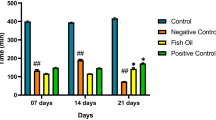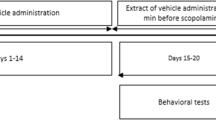Abstract
Ferulago angulata (Apiaceae) is a shrub indigenous to western Iran, Turkey and Iraq. In traditional medicine, F. angulata is recommended for treating digestive pains, hemorrhoids, snake bite, ulcers and as sedative. In the present study, the effects of inhaled F. angulata essential oil (1 and 3 %, daily, for 21 days) on spatial memory performance were assessed in scopolamine-treated rats. Scopolamine-induced memory impairments were observed, as measured by the Y-maze and radial arm-maze tasks. Decreased activities of superoxide dismutase, glutathione peroxidase and catalase along with increase of acetylcholinesterase activity and decrease of total content of reduced glutathione were observed in the rat hippocampal homogenates of scopolamine-treated animals as compared with control. Production of protein carbonyl and malondialdehyde significantly increased in the rat hippocampal homogenates of scopolamine-treated animals as compared with control, as a consequence of impaired antioxidant enzymes activities. Additionally, in scopolamine-treated rats exposure to F. angulata essential oil significantly improved memory formation and decreased oxidative stress, suggesting memory-enhancing and antioxidant effects. Therefore, our results suggest that multiple exposures to F. angulata essential oil ameliorate scopolamine-induced spatial memory impairment by attenuation of the oxidative stress in the rat hippocampus.




Similar content being viewed by others
References
Xu P-x, Wang S-w, Yu X-l, Su Y-j, Wang T, Zhou W-w, Zhang H, Wang Y-j, Liu R-t (2014) Rutin improves spatial memory in Alzheimer’s disease transgenic mice by reducing Aβ oligomer level and attenuating oxidative stress and neuroinflammation. Behav Brain Res 264:173–180
Mathew M, Subramanian S (2014) In vitro screening for anti-cholinesterase and antioxidant activity of methanolic extracts of ayurvedic medicinal plantsused for cognitive disorders. PLoS ONE 9:e86804
Ebert U, Kirch W (1998) Scopolamine model of dementia: electroencephalogram findings and cognitive performance. Eur J Clin Invest 28:944–949
Klinkenberg I, Blokland A (2010) The validity of scopolamine as a pharmacological model for cognitive impairment: a review of animal behavioral studies. Neurosci Biobehav Rev 34:1307–1350
Eastonn A, Douchamps V, Eacott M, Lever C (2012) A specific role for septohippocampal acetylcholine in memory? Neuropsychologia 50:3156–3168
Kwon SH, Ma SX, Joo HJ, Lee SY, Jang CG (2013) Inhibitory effects of Eucommia ulmoides Oliv. bark on scopolamine-induced learning and memory deficits in mice. Biomol Ther 21:462–469
Moreira PI, Nunomura A, Nakamura M, Takeda A, Shenk JC, Aliev G, Smith MA, Perry G (2008) Nucleic acid oxidation in Alzheimer disease. Free Radic Biol Med 44:1493–1505
Ischiropoulos H, Beckman JS (2003) Oxidative stress and nitration in neurodegeneration: cause, effect, or association? J Clin Invest 111:163–169
Luque-Contreras D, Carvajal K, Toral-Rios D, Franco-Bocanegra D, Campos-Pena V (2014) Oxidative stress and metabolic syndrome: cause or consequence of Alzheimer’s disease? Oxid Med Cell Longev 2014. Article ID 497802:11
Dumont M, Beal MF (2011) Neuroprotective strategies involving ROS in Alzheimer disease. Free Radic Biol Med 51:1014–1026
Coppede F, Migliore L (2009) DNA damage and repair in Alzheimer’s disease. Curr Alzheimer Res 6:36–47
Lovell MA, Markesbery WR (2008) Oxidatively modified RNA in mild cognitive impairment. Neurobiol Dis 29:169–175
Pinto E, Hrimpeng K, Lopes G, Vaz S, Gonçalves MJ, Cavaleiro C, Salgueiro L (2013) Antifungal activity of Ferulago capillaris essential oil against Candida, Cryptococcus, Aspergillus and dermatophyte species. Eur J Clin Microbiol Infect Dis 32:1311–1320
Pirbalouti A, Sedaghat L, Hamedi B, Tirgir F (2013) Chemical composition and antioxidant activity of essential oils of three endemic medicinal plants of Iran. Bangl J Bot 42:327–332
Rafieian-kopaei M, Shahinfard N, Rouhi-Boroujeni H, Gharipour M, Darvishzadeh-Boroujeni P (2014) Effects of Ferulago angulata extract on serum lipids and lipid peroxidation. Evid Based Complement Alternat Med 2014, Article ID 680856:4
Adams RP (2007) Identification of essential oil by Gas Chromatography/Mass Spectroscopy. Allured Publishing Corporation, Carol Stream, Illinois
Gradinariu V, Cioanca O, Hritcu L, Trifan A, Gille E, Hancianu M (2014) Comparative efficacy of Ocimum sanctum L. and Ocimum basilicum L. essential oils against amyloid beta (1–42)-induced anxiety and depression in laboratory rats. Phytochem Rev. doi:10.1007/s11101-014-9389-6
Linck VM, da Silva AL, Figueiró M, Caramão EB, Moreno PRH, Elisabetsky E (2010) Effects of inhaled Linalool in anxiety, social interaction and aggressive behavior in mice. Phytomedicine 17:679–683
Hritcu L, Noumedem J, Cioanca O, Hancianu M, Kuete V, Mihasan M (2014) Methanolic extract of Piper nigrum fruits improves memory impairment by decreasing brain oxidative stress in amyloid beta(1–42) rat model of Alzheimer’s disease. Cell Mol Neurobiol 34:437–449
Cioanca O, Hritcu L, Mihasan M, Hancianu M (2013) Cognitive-enhancing and antioxidant activities of inhaled coriander volatile oil in amyloid β(1–42) rat model of Alzheimer’s disease. Physiol Behav 120:193–202
Ellman G, Courtney K, Andres VJ, Feather-Stone R (1961) A new and rapid colorimetric determination of acetylcholinesterase activity. Biochem Pharmacol 7:88–95
Srikumar B, Ramkumar K, Raju T, Shankaranarayana Rao B (2004) Assay of acetylcholinesterase activity in the brain. In: Raju T, Kutty B, Sathyaprabha T, Shanakranarayana Rao B (eds) Brain and Behavior. National Institute of Mental Health and Neurosciences, Bangalore, pp 142–144
Winterbourn C, Hawkins R, Brian M, Carrell R (1975) The estimation of red cell superoxide dismutase activity. J Lab Clin Med 85:337
Sinha AK (1972) Colorimetric assay of catalase. Anal Biochem 47:389–394
Sharma M, Gupta YK (2002) Chronic treatment with trans resveratrol prevents intracerebroventricular streptozotocin induced cognitive impairment and oxidative stress in rats. Life Sci 7:2489–2498
Fukuzawa K, Tokumura A (1976) Glutathione peroxidase activity in tissues of vitamin E-deficient mice. J Nutr Sci Vitaminol 22:405–407
Oliver CN, Ahn BW, Moerman EJ, Goldstein S, Stadtman ER (1987) Age-related changes in oxidized proteins. J Biol Chem 262:5488–5491
Luo S, Wehr NB (2009) Protein carbonylation: avoiding pitfalls in the 2,4-dinitrophenylhydrazine assay. Redox Rep 14:159–166
Ohkawa H, Ohishi N, Yagi K (1979) Assay for lipid peroxides in animal tissues by thiobarbituric acid reaction. Anal Biochem 95:351–358
Smith PK, Krohn RI, Hermanson GT, Mallia AK, Gartner FH, Provenzano MD, Fujimoto EK, Goeke NM, Olson BJ, Klenk DC (1985) Measurement of protein using bicinchoninic acid. Anal Biochem 150:76–85
Chuong NN, Trung BH, Luan TC, Hung TM, Dang NH, Dat NT (2014) Anti-amnesic effect of alkaloid fraction from Lycopodiella cernua (L.) Pic. Serm. on scopolamine-induced memory impairment in mice. Neurosci Lett 575:42–46
Lee S, Kim J, Seo SG, Choi B-R, Han J-S, Lee KW, Kim J (2014) Sulforaphane alleviates scopolamine-induced memory impairment in mice. Pharmacol Res 85:23–32
Lee J-S, Kim H-G, Han J-M, Kim D-W, Yi M-H, Son S-W, Kim Y-A, Lee J-S, Choi M-K, Son C-G (2014) Ethanol extract of Astragali Radix and Salviae Miltiorrhizae Radix, Myelophil, exerts anti-amnesic effect in a mouse model of scopolamine-induced memory deficits. J Ethnopharmacol 153:782–792
Park SJ, Jung JM, Lee HE, Lee YW, Kim DH, Kim JM, Hong JG, Lee CH, Jung IH, Cho Y-B, Jang DS, Ryu JH (2012) The memory ameliorating effects of INM-176, an ethanolic extract of Angelica gigas, against scopolamine- or Aβ1–42-induced cognitive dysfunction in mice. J Ethnopharmacol 143:611–620
Kim K, Bu Y, Jeong S, Lim J, Kwon Y, Cha DS, Kim J, Jeon S, Eun J, Jeon H (2006) Memory-enhancing effect of a supercritical carbon dioxide fluid extract of the needles of Abies koreana on scopolamine-induced amnesia in mice. Biosci Biotechnol Biochem 70:1821–1826
Perry NSL, Houghton PJ, Theobald A, Jenner P, Perry EK (2000) In-vitro inhibition of human erythrocyte acetylcholinesterase by Salvia lavandulaefolia essential oil and constituent terpenes. J Pharm Pharmacol 52:895–902
Loizzo MR, Menichini F, Tundis R, Bonesi M, Conforti F, Nadjafi F, Statti GA, Frega NG, Menichini F (2009) In vitro biological activity of Salvia leriifolia benth essential oil relevant to the treatment of Alzheimer’s disease. J Oleo Sci 58:443–446
Falsafi SK, Deli A, Höger H, Pollak A, Lubec G (2012) Scopolamine administration modulates muscarinic, nicotinic and NMDA receptor systems. PLoS ONE 7:e32082
Tota S, Hanif K, Kamat P, Najmi A, Nath C (2012) Role of central angiotensin receptors in scopolamine-induced impairment in memory, cerebral blood flow, and cholinergic function. Psychopharmacology 222:185–202
Abreu-Villaça Y, Filgueiras CC, Manhães AC (2011) Developmental aspects of the cholinergic system. Behav Brain Res 221:367–378
Shi J, Liu Q, Wang Y, Luo G (2010) Coadministration of huperzine A and ligustrazine phosphate effectively reverses scopolamine-induced amnesia in rats. Pharmacol Biochem Behav 96:449–453
Stadtman E (1992) Protein oxidation and aging. Science 257:1220–1224
Lee M-R, Yun B-S, Park S-Y, Ly S-Y, Kim S-N, Han B-H, Sung C-K (2010) Anti-amnesic effect of Chong–Myung–Tang on scopolamine-induced memory impairments in mice. J Ethnopharmacol 132:70–74
Acknowledgments
Emel Aydin was supported by LLP Erasmus (2013/2014) during her stage within Alexandru Ioan Cuza University of Iasi, Romania.
Author information
Authors and Affiliations
Corresponding author
Ethics declarations
Conflict of interests
The authors have declared that no competing interests exist.
Ethical standard
This study was approved by the Committee on the Ethics of Animal Experiments of the Alexandru Ioan Cuza University of Iasi (Permit Number: 2192) and also, efforts were made to minimize animal suffering and to reduce the number of animals used.
Rights and permissions
About this article
Cite this article
Hritcu, L., Bagci, E., Aydin, E. et al. Antiamnesic and Antioxidants Effects of Ferulago angulata Essential Oil Against Scopolamine-Induced Memory Impairment in Laboratory Rats. Neurochem Res 40, 1799–1809 (2015). https://doi.org/10.1007/s11064-015-1662-6
Received:
Revised:
Accepted:
Published:
Issue Date:
DOI: https://doi.org/10.1007/s11064-015-1662-6




